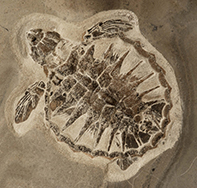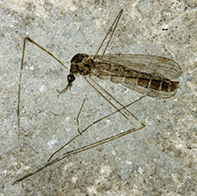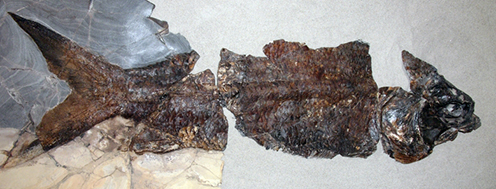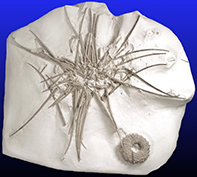Danekræ fossil trove collection

Juvenile sea turtle Tasbacka danica DK 567 (Photo: Sten L. Jakobsen)
Curator
Collection manager
Ida Bonnevier Wallstedt
About the collection
The Danekræ collection contains fossils, minerals, rocks and meteorites from Denmark, which have been deemed “national fossil trove” of unique scientific or exhibition value.
By far the majority of specimens in the collection are fossil remains of prehistoric organisms ranging from the Cambrian up to and including the late Pleistocene, with a few mineral, rock and meteorite specimens as well.
Among the Danekræ, fossil insects and fish dominate, each group making up around 30% of recognized trove specimens. Furthermore, just above 60% of all fossil trove specimens derive from the latest Paleocene – lowermost Eocene deposits in the Limfjord area of northern Jutland, Denmark.

Fossil crane fly (Tipula sp.) DK 138 (Photo: Sten L. Jakobsen)
Danekræ collection in numbers
- Number of specimens: 1,000
- Types: Several
- Digitally available specimens: All
- Percentage digitized: 100%
Strengths
Several hundred fossils of outstanding exhibition value, supporting valuable public outreach and mediation efforts in Denmark; or of national and international scientific value; or both (see examples in section "Important specimens" below).
Important specimens
- A number of extremely rare, articulated specimens of starfish from the Maastrichtian and Paleocene chalk and limestone deposits (including genera Crateraster, Metopaster, Nymphaster and Recurvaster). These specimens allow the reconstruction of the skeletal morphology of these animals in much more precise detail than hitherto known.
- Securely-dated specimens of ammonites from earliest Paleocene limestones, documenting survival of this otherwise-thought extinct group for some time after the Cretaceous-Paleogene mass extinction event.
- Extremely well-preserved specimens of lowermost Eocene fossil Osteglossomorphae, including the holotypes of Heterosteoglossum foreyi, Xosteoglossid rebeccae, and Brychaetoides greenwoodi. These specimens document an unexpectedly high marine diversity among a group of fish, which nowadays are exclusively freshwater and only found in the southern hemisphere.
- A large diversity of fossil insects from the latest Paleocene and earliest Eocene, many of which document the earliest occurrence of modern groups.
- Fossil specimens of lowermost Eocene birds from the Fur Formation, including specimens of Eocypselus, Lithornis, Morsoravis (type), Rhynchaeites and Septentrogon (type). These exquisitely-preserved specimens are among the earliest well-dated fossils documenting a high diversity of Anatomically modern birds (Neornithes) and have contributed significantly as well-constrained dating points to molecular clock studies of bird evolution.
- Fossil bird head with feather impressions from the lowermost Eocene (Danekræ DK 200), a key specimen which allowed the first correct identification and description of fossil melanosomes in fossil bird and dinosaur feathers.
- A complete juvenile sea-turtle referred to the new species Tasbacka danica, with soft tissue preservation and outstanding exhibitional value.

Fossil tarpon-like fish (Elopiformes) DK 491 (Photo: Sten L. Jakobsen)
History
The concept of ”Danekræ” was created with the 1989 revision of the national museum law to ensure that fossil or subfossil specimens of exceptional national value, as well as meteorites from Denmark were preserved for scientific and exhibition purposes.
Danekræ fossil trove are geological, botanical or zoological objects of fossil or subfossil nature, or meteorites found in Denmark, if the object is of unique scientific or exhibitional value. Specimens must either physically derive from Denmark or have been transported here by non-human means (such as ice age glaciers). Fossil trove belongs to the state, and any person who finds or gains possession of fossil trove after 1989, shall immediately deliver it to the Natural History Museum of Denmark, or a nationally recognized local natural history museums.

Fossil sea urchin Phymosoma granulosum DK 154 (Photo: Sten L. Jakobsen)
By far the largest amount of specimens evaluated for – and eventually declared as - Danekræ status have been the fossil or subfossil remains of animals or plants. As of 2016, one rock and two mineral specimens have also been declared fossil trove.
Special mention must be made of the two Danekræ meteorite troves, namely the Maribo fall of 2009 and Ejby meteorite in 2015. Without the Danekræ legislation these extremely valuable specimens could not have been retained for scientific studies, as well as exhibition and public outreach purposes. The Danekræ meteorite specimens are physically housed in the Danish meteorite collection.
While the Danekræ fossil trove collection is physically housed and formally registered at the Natural History Museum of Denmark, a large number of specimens are on long-term display at local natural history museums around Denmark, usually closely associated with the localities they were discovered in.

Complete wing of fossil grasshopper Pseudotettigonia amoena DK 347 (Photo: Sten L. Jakobsen)
